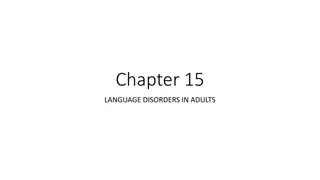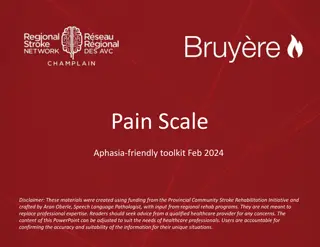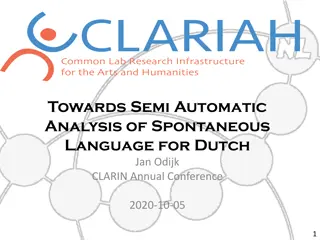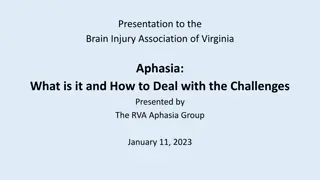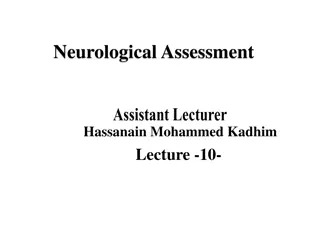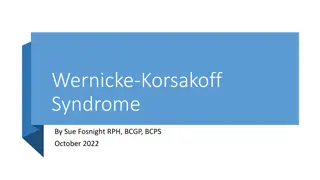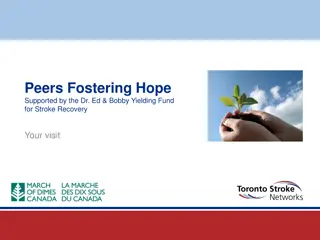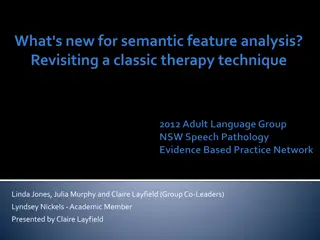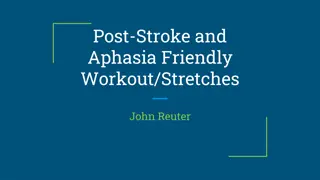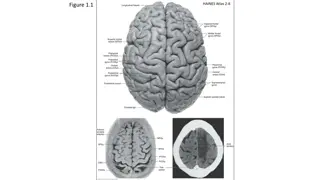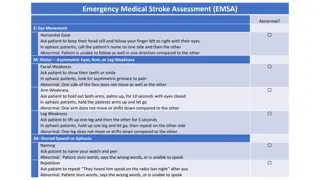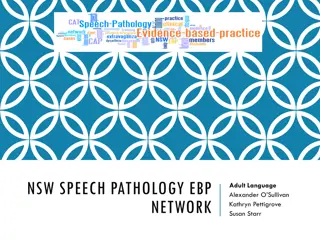Understanding Neurogenic Speech and Language Disorders in Adults
This chapter provides insight into language disorders in adults, including types of aphasia, causes such as toxins, traumatic brain injury, brain tumors, and strokes. It discusses cerebral hemorrhage, occlusive strokes, ischemic stroke, transient ischemic attacks, and cerebral thrombosis. The conten
1 views • 34 slides
Pain Scale Aphasia-Friendly Toolkit - Feb 2024
Created under the Provincial Community Stroke Rehabilitation Initiative, this toolkit helps individuals express and communicate their pain levels effectively, featuring detailed descriptions and ratings tailored for those with aphasia. Users are urged to consult healthcare professionals for personal
0 views • 13 slides
Semi-Automatic Analysis of Spontaneous Language for Dutch
Develop an application to semi-automatically analyze spontaneous language transcripts for Dutch, focusing on language development disorders such as aphasia. The goal is to automate the manual analysis process using language technology, with methods like TARSP, STAP, and ASTA. The SASTA application a
0 views • 39 slides
Understanding Aphasia and Its Impact: Presentation to RVA Aphasia Group
Explore aphasia, a language disorder affecting communication, as discussed in a presentation to the Brain Injury Association of Virginia by the RVA Aphasia Group. Learn about its causes, symptoms, statistics, and the importance of early speech therapy evaluation. Participants include speech-language
0 views • 19 slides
Understanding Neurological Exams: Assessment and Procedures
A neurological exam evaluates a person's nervous system using various instruments in a healthcare setting. This comprehensive assessment includes evaluating motor and sensory functions, balance, coordination, mental status, reflexes, and cranial nerve functionality. Assessing mental status involves
0 views • 18 slides
Understanding Wernicke-Korsakoff Syndrome: Overview and Clinical Considerations
Wernicke-Korsakoff Syndrome (WKS) comprises Wernicke's Encephalopathy (WE) and Korsakoff Syndrome. WE presents with altered mental status, ocular signs, and ataxia, while Korsakoff Syndrome manifests as amnesia and confabulations. Untreated WE can progress to Korsakoff Syndrome in about 80% of cases
0 views • 52 slides
Stroke Recovery Peer Support Program Guidelines
Learn about the "Peers Fostering Hope Supported by the Dr. Ed & Bobby Yielding Fund for Stroke Recovery" initiative aiming to re-engage and re-integrate stroke survivors into the community. Explore how peer visitors provide support, encouragement, and hope for community re-engagement and reintegrati
1 views • 16 slides
Revisiting Semantic Feature Analysis: A Classic Therapy Technique
Aphasia often involves semantic breakdown, and Semantic Feature Analysis (SFA) is a foundational technique for various treatments addressing semantic impairments. This presentation explores the effectiveness of SFA in improving naming, generalization to spontaneous speech, and treatment goals beyond
0 views • 16 slides
Post-Stroke & Aphasia Friendly Workout Stretches for Improved Movement
Explore a specialized workout routine designed to enhance movement post-stroke. These exercises focus on improving balance, strength, endurance, and coordination, aiding in tasks such as walking and fine motor skills. Discover the benefits of incorporating muscle strengthening exercises post-stroke
0 views • 22 slides
Aphasia Book Club - Chapters 6-7 Discussion Summary
The Aphasia Book Club held a discussion on chapters 6-7 of "The 100-Year-Old Man Who Climbed Out the Window and Disappeared" on September 25, 2020. Breakout groups explored personal goals for the club, fun weekend plans, and questions on earlier chapters. Key questions from the discussion related to
0 views • 30 slides
Neuroanatomy Atlas Figures - Haines & Blumenfeld
Explore a collection of detailed neuroanatomy images from the Haines Atlas and Blumenfeld, showcasing structures and areas of the brain associated with language processing, sensory functions, and more. Learn about Broca and Wernicke aphasia, cerebral hemispheres, major cisterns, and midline structur
0 views • 15 slides
Emergency Medical Stroke Assessment (EMSA) Abnormal Signs & Evaluation
This comprehensive guide outlines the Emergency Medical Stroke Assessment (EMSA) protocol for assessing potential stroke patients. It covers the evaluation of abnormal signs related to eye movement, motor weaknesses in the face, arms, and legs, as well as slurred speech or aphasia. The assessment in
0 views • 9 slides
Evidence-Based Practices in Discourse Treatments for Aphasia
This research review explores the effectiveness of discourse treatments for aphasia, focusing on improvements in discourse that lead to better outcomes for individuals with aphasia. Various treatment techniques and outcome measures are discussed, highlighting the potential benefits of specific inter
0 views • 14 slides
